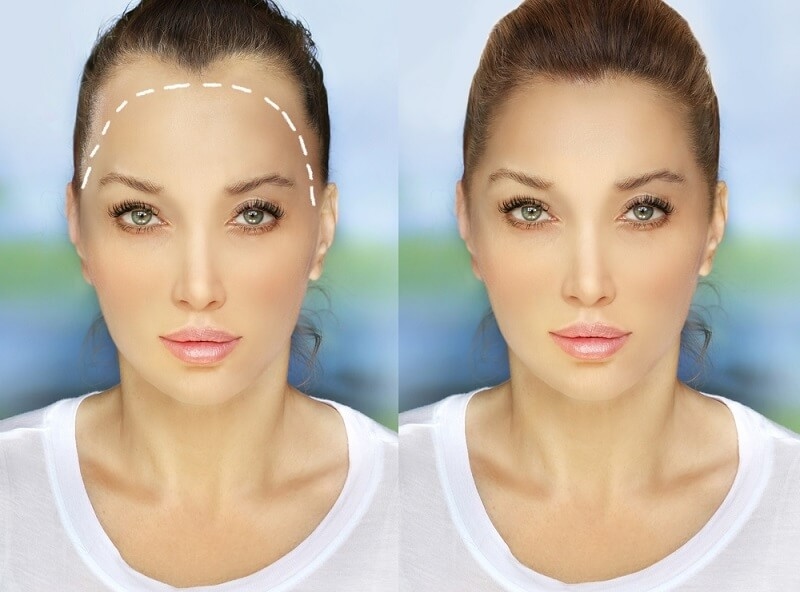
A high hairline can throw off facial symmetry. And when that high hairline edges into receding hairline territory, it’s not just about aesthetics anymore—it chips away at confidence. While treatments like PRP, minoxidil, or transplants dominate the hair loss space, there's another route that's more immediate: hairline lowering surgery.
Also known as forehead reduction surgery, this cosmetic fix doesn’t aim to regrow hair—it repositions your existing hairline to where it should’ve been all along. So the big question is: does this type of cosmetic hair surgery actually fix a receding hairline, or is it just a high-dollar band-aid?
Let’s break it down without the fluff.
Hairline lowering surgery is a cosmetic procedure where the surgeon removes a strip of skin from the upper forehead and pulls the scalp forward, effectively dropping the hairline by about 1.5 to 3 cm. Think of it as pulling the curtain down—not adding new threads, but repositioning what you’ve already got.
This isn’t your typical hairline transplant. There's no follicle relocation from the back of your head. It’s more architectural—reshaping the frame of your face by correcting a disproportionate forehead. Most candidates have either a naturally high forehead, a receding hairline, or both.
This is forehead reduction surgery, plain and simple. It's surgical, it's intentional, and it's a bold move for the right candidate.
Don’t Miss: Protect Your Hair Daily: Best Heat Protectant Spray Guide
Not everyone with hair loss is a match for this. Let’s be clear.
You're a good candidate for hairline lowering surgery if:
This isn’t the best fit if:
This is a precision cosmetic fix—not a magic cure. And that matters.
So what actually happens during forehead reduction surgery?
Here’s the process:
Surgery takes about 1–2 hours. Most people walk out the same day. Recovery? Roughly two weeks for the swelling and tightness to settle. Final results become clear after a couple of months.
And yes—this qualifies as cosmetic hair surgery, not medical hair restoration. There's a difference, and knowing it saves disappointment.

Short answer: It can—but only in the right cases.
If your receding hairline is due to genetics and still actively retreating, this surgery won’t stop the underlying cause. You may need to pair it with hairline transplant work later to maintain the new frame.
But if you’ve got a stable pattern or a naturally high hairline that hasn’t changed much in years, hairline lowering surgery offers immediate correction. There’s no waiting a year to see regrowth. The change is visible when you leave the clinic.
That said, many top surgeons combine this with future grafting or PRP for density in the temple zones. It’s all about planning the long game, not chasing quick fixes.
This isn’t cheap—and it shouldn’t be.
In the U.S., hairline lowering surgery costs anywhere from $23,000 to $28,000, depending on the surgeon, city, and whether anesthesia or additional treatments are included. Insurance won’t touch it—it’s elective, and it’s cosmetic.
Worth it? If you’re the right candidate, absolutely. You’re paying for symmetry, facial balance, and a boost that topical treatments rarely deliver this fast.
Recovery isn’t brutal, but it’s not a walk in the park either.
Most people go back to work after a week—especially if you work remotely or can wear a headband without questions.
Long-term scar visibility depends on your hair density, healing ability, and how stable your hairline remains. That’s why combining this with future hair loss solutions makes sense.
Here’s the real difference between hairline lowering surgery and a hairline transplant:
| Hairline Lowering Surgery | Hairline Transplant |
| Pulls scalp forward to lower hairline | Moves individual follicles to the front |
| Instant result | Full results take 12–18 months |
| One surgery, quick payoff | May need multiple sessions |
| Great for stable hairlines | Works even if loss is progressive |
| Scar hidden by hairline | Tiny dot scars at donor site |
The best part? You don’t have to choose one or the other. Plenty of patients get hairline lowering first, then a mini hairline transplant to add density around the temples or soften the transition.
Yes and no.
The surgical part is permanent. Your new hairline stays where it was placed. But if your surrounding hair starts to thin years later, that scar may peek through. That’s where maintenance and future hair loss solutions come in.
If you’re proactive—think minoxidil, PRP, even a conservative finasteride regimen if appropriate—you can maintain the look for decades. And if anything shifts, a few grafts can reinforce the design.
So no, it won’t “cure” hair loss. But yes, it can reset the frame and give you a better starting point.
This is why a proper evaluation matters. One bad candidate can ruin what could’ve been a great result for someone else.
This isn’t just for celebrities or social media influencers. Women with postpartum hair loss, men with naturally high hairlines, trans patients seeking gender-affirming changes—it’s broader than you think.
Chrissy Teigen opened up about having it done after experiencing postpartum thinning. That honesty gave others permission to consider options beyond lotions and hope.
More people are realizing that cosmetic hair surgery isn’t about vanity—it’s about control. And sometimes, it’s about getting back a version of your face that feels like you again.
More to Discover: Reduce Hair Fall & Strengthen Strands: Home Care Routine
If your receding hairline is making you feel like your face has shifted out of proportion—and it’s not due to ongoing, aggressive thinning—hairline lowering surgery is a valid solution. Not a gimmick. Not a trend. A real, surgical fix with real, visible payoff.
But it’s not a one-size-fits-all procedure.
Pair it with smart hair loss solutions like PRP or even a small hairline transplant down the line, and you’re setting yourself up for the best result—not just now, but five years from now too.
This content was created by AI